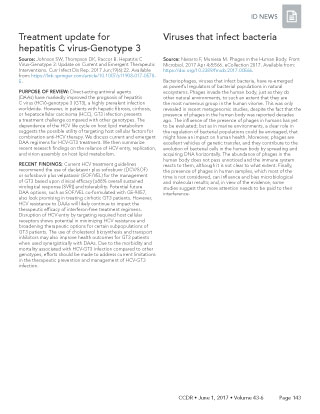ID News: June 2017

 Download this article as a PDF (62 KB - 1 page)
Download this article as a PDF (62 KB - 1 page) Published by: The Public Health Agency of Canada
Issue: Volume 43-6: Indigenous health
Date published: June 1, 2017
ISSN: 1481-8531
Submit a manuscript
About CCDR
Browse
Volume 43-6, June 1, 2017: Indigenous health
ID News
Treatment update for hepatitis C virus-Genotype 3
Source: Johnson SW, Thompson DK, Raccor B. Hepatitis C Virus-Genotype 3: Update on Current and Emergent Therapeutic Interventions. Curr Infect Dis Rep. 2017 Jun;19(6):22.
PURPOSE OF REVIEW: Direct-acting antiviral agents (DAAs) have markedly improved the prognosis of hepatitis C virus (HCV)-genotype 3 (GT3), a highly prevalent infection worldwide. However, in patients with hepatic fibrosis, cirrhosis, or hepatocellular carcinoma (HCC), GT3 infection presents a treatment challenge compared with other genotypes. The dependence of the HCV life cycle on host lipid metabolism suggests the possible utility of targeting host cellular factors for combination anti-HCV therapy. We discuss current and emergent DAA regimens for HCV-GT3 treatment. We then summarize recent research findings on the reliance of HCV entry, replication, and virion assembly on host lipid metabolism.
RECENT FINDINGS: Current HCV treatment guidelines recommend the use of daclatasvir plus sofosbuvir (DCV/SOF) or sofosbuvir plus velpatasvir (SOF/VEL) for the management of GT3 based upon clinical efficacy [≥88% overall sustained virological response (SVR)] and tolerability. Potential future DAA options, such as SOF/VEL co-formulated with GS-9857, also look promising in treating cirrhotic GT3 patients. However, HCV resistance to DAAs will likely continue to impact the therapeutic efficacy of interferon-free treatment regimens. Disruption of HCV entry by targeting required host cellular receptors shows potential in minimizing HCV resistance and broadening therapeutic options for certain subpopulations of GT3 patients. The use of cholesterol biosynthesis and transport inhibitors may also improve health outcomes for GT3 patients when used synergistically with DAAs. Due to the morbidity and mortality associated with HCV-GT3 infection compared to other genotypes, efforts should be made to address current limitations in the therapeutic prevention and management of HCV-GT3 infection.
Viruses that infect bacteria
Source: Navarro F, Muniesa M. Phages in the Human Body. Front Microbiol. 2017 Apr 4;8:566. eCollection 2017.
Bacteriophages, viruses that infect bacteria, have re-emerged as powerful regulators of bacterial populations in natural ecosystems. Phages invade the human body, just as they do other natural environments, to such an extent that they are the most numerous group in the human virome. This was only revealed in recent metagenomic studies, despite the fact that the presence of phages in the human body was reported decades ago. The influence of the presence of phages in humans has yet to be evaluated; but as in marine environments, a clear role in the regulation of bacterial populations could be envisaged, that might have an impact on human health. Moreover, phages are excellent vehicles of genetic transfer, and they contribute to the evolution of bacterial cells in the human body by spreading and acquiring DNA horizontally. The abundance of phages in the human body does not pass unnoticed and the immune system reacts to them, although it is not clear to what extent. Finally, the presence of phages in human samples, which most of the time is not considered, can influence and bias microbiological and molecular results; and, in view of the evidence, some studies suggest that more attention needs to be paid to their interference.
Page details
- Date modified: